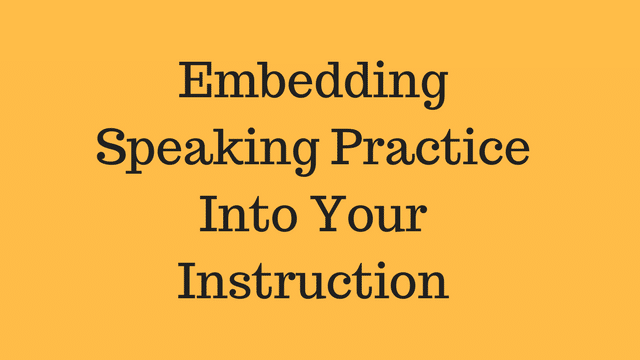Last Updated on June 25, 2021
 Interaction, oral language, speaking practice, cooperative learning, discussion groups–there are many ways to have students practice speaking and listening using academic language.
Interaction, oral language, speaking practice, cooperative learning, discussion groups–there are many ways to have students practice speaking and listening using academic language.
Practice is necessary for students to develop into people who can articulate their thoughts and communicate effectively. And for English learners, speaking practice is critical. Research shows that oral proficiency won’t increase without opportunities to speak and practice using academic language. So, we need a balance between student and teacher talk. In a class of 30 students in a traditional classroom, even if each one is called on, how much language do students produce?
As teachers, we can plan times and activities where students engage in conversations and listen to each other, so they can build their language around academic experiences.
There are many ways to incorporate speaking practice into instruction. The first step is planning for purposeful talk and providing many opportunities for interaction.
NOTE: It may be helpful to give the prompts or questions (What is the most important..? What are the reasons…? What are the pros and cons of…?) before you start the activity, so students have a chance to reflect and prepare what they will say before practicing their language skills. This is especially helpful for your quiet students and for English learners.
3, 2, 1
After listening to an audio story, students think about 3 things they learned, 2 questions they have, and 1 thing they enjoyed about the story, and then share with another student.
Musical Share
This activity provides language practice and the opportunity to share ideas with multiple classmates. Provide a prompt or question and give students time to write their response. Then play music as students walk around. Stop the music and have students find a partner near them to share their response. Then, continue the music and repeat the activity until students have sufficient practice with multiple classmates. This can also be done with tables placed around the room. When the music stops, students sit at the table closest to them and discuss with the other classmates at the same table.
Parallel Line Share
Similar to the musical share, this is a more structured way to pair students for conversation. Students form two lines facing each other. Students can discuss their response with the classmate in front of them, then when the time is up, one line moves to the right and pairs with a new classmate. The person on the end walks up to the beginning of the line.
Hear, Think, Wonder
This is a way to have students process the information they heard in the audio story. They can write their responses to these questions and then share with a partner.
- What did you hear?
- What did you think about that?
- What does it make you wonder?
Opinions and Evidence
This can help students think deeply about the content and use language to explain their position. After listening to a story, ask a central question and offer two possible answers. Students choose one answer–the one they think best answers the question, and then they discuss their opinion with a small group. As a class, students can defend their opinions, citing evidence from the story or their background knowledge. Encourage them to listen to everyone carefully and allow students to change their opinion.
News Station Reader’s Theater
Increase students’ fluency by using the transcript and having students take the roles of the speakers in the audio story. They can practice their roles, listen multiple times to the audio story, and then perform the story for the class.
Create a Commercial
Students, in groups, write a 30-second commercial about the audio story, summarizing its main idea and what they liked about it, to encourage others to listen to the story. Then groups present the commercials to the class.
Think-Pair-Share
This is a great way to maximize discussion time for middle and high school students. After listening to an audio story, give students time to think independently, then discuss their ideas with a partner and then share with the class. You can have them react to the story in general, or pose a question or idea for them to think about.
Other Resources-
Cult of Pedagogy: The Big List of Class Discussion Strategies
Teaching Tolerance: Community Inquiry
Colorin Colorado:
- Using Pair and Group Work to Develop ELLs’ Oral Language Skills
- Academic Language and ELLs: What Teachers Need to Know
Edutopia:
